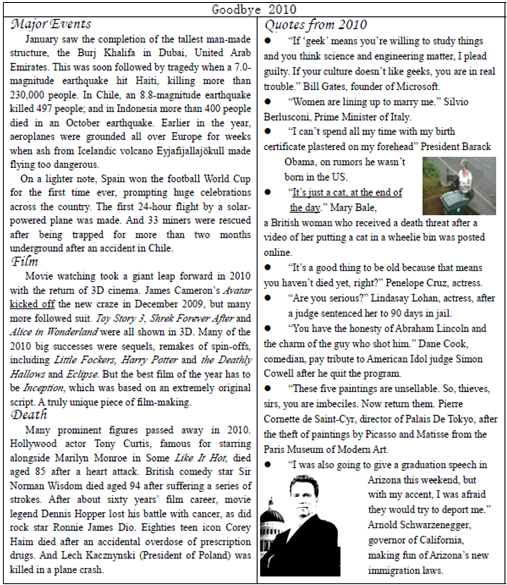题目内容
2.Five years ago,when I taught art at a school in Seattle,I used Tinkertoys as a test at the beginning of a term to find out something about my students.I put a small set of Tinkertoys in front of each student,and said:"Make something out of the Tinkertoys.You have 45minutes today-and 45minutes each day for the rest of the week."A few students hesitated to start.They waited to see the rest of the class would do.Several others checked the instructions and made something according to one of the model plans provided.Another group built something out of their own imaginations.
Once I had a boy who worked experimentally with Tinkertoys in his free time.His constructions filled a shelf in the art classroom and a good part of his bedroom at home.I was delighted at the presence of such a student.Here was an exceptionally creative mind at work.His presence meant that I had an unexpected teaching assistant in class whose creativity would infect(感染) other students.
Encouraging this kind of thinking has a downside.I ran the risk of losing those students who had a different style of thinking.Without fail one would declare,"But I'm just not creative."
"Do you dream at night when you're asleep?"
"Oh,sure."
"So tell me one of your most interesting dreams."The student would tell something wildly imaginative.Flying in the sky or in a time machine or growing three heads."That's pretty creative.Who does that for you?"
"Nobody.I do it."
"Really-at night,when you're asleep?"
"Sure."
"Try doing it in the daytime,in class,okay?"
5.The teacher used Tinkertoys in class in order toA?
A.know more about the students
B.make the lessons more exciting
C.raise the students'interest in art
D.teach the students about toy design
6.What do we know about the boy mentioned in Paragraph 3?D
A.He liked to help his teacher.
B.He preferred to study alone.
C.He was active in class.
D.He was imaginative.
7.What does the underlined word"downside"in Paragraph 4probably mean?B
A.Mistake.
B.Drawback.
C.Difficulty.
D.Burden.
8.Why did the teacher ask the students to talk about their dreams?A
A.To help them to see their creativity.
B.To find out about their sleeping habits.
C.To help them to improve their memory.
D.To find out about their ways of thinking.
分析 本文属于记叙文,作者通过这篇文章主要向我们描述了让学生拼装玩具发现并鼓励学生的创造性和想象力.
解答 5.A 推理判断题.根据文章第二段可知当我把拼装式玩具放在学生面前的时候,有些学生犹豫着在等着看别人如何行动,有一些学生查看了使用说明并根据模型做出了一些东西.而另外一些学生则根据本人的想象力做出了一些东西.通过观察我对不同的学生的性格有了不同的理解.故选A.
6.D 推理判断 第三段第一句提到男孩在空闲时间拼装玩具,由Here was an exceptionally creative mind at work.可知他很有想象力和创造性;故选D.
7.B 语义猜测题. 由文章第四段I ran the risk of losing those students who had a different style of thinking.可知我的教育方法也有不足之处.故划线部分单词意为缺点;故选B.
8.A 推理判断题.根据文章最后七段中的对话内容可知作者鼓励孩子们说出最有趣的有创造性和想象力的梦,并鼓励他们在白天的课堂里把梦的内容做出来.作者这样做的目的就是为了让他们看到自己的创造性和想象力.故选A.
点评 考察学生的细节理解和推理判断能力,做细节理解题时一定要找到文章中的原句,和题干进行比较,再做出正确的选择.在做推理判断题不要以个人的主观想象代替文章的事实,要根据文章事实进行合乎逻辑的推理判断.

练习册系列答案
相关题目
12.-Wang Gang shows no interest in all the subjects,and goes to Bingyu Internet Bar to surf the Internet every night!
-Oh,that's too bad.He is______ to fail in the final exam.( )
-Oh,that's too bad.He is______ to fail in the final exam.( )
| A. | relevant | B. | bound | C. | adjusting | D. | passive |
13.-Tom has made great progress in spelling.
-So he has and _____.( )
-So he has and _____.( )
| A. | so do you | B. | so have you | C. | so you do | D. | so you have |
11.Yesterday we went to the library to do some reading,only to find that it ______.( )
| A. | had closed | B. | had been closed | C. | wil close | D. | will be closed |
9.I want to learn about your holidays.Could you tell me how you usually______Thanksgiving Day in your country?( )
| A. | congratulate | B. | remind | C. | remember | D. | observe |
